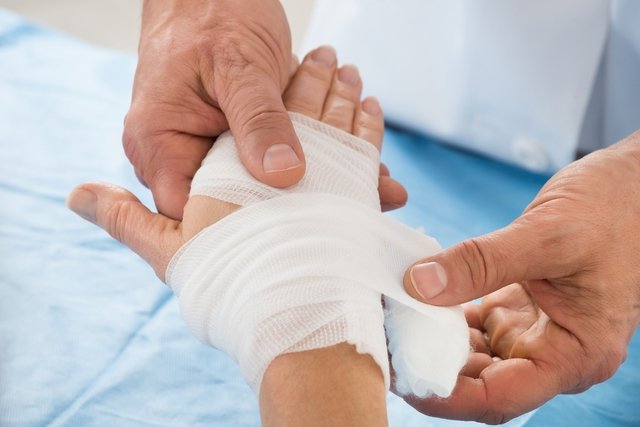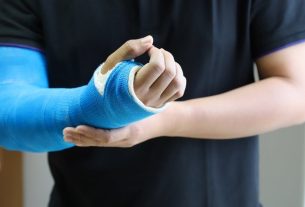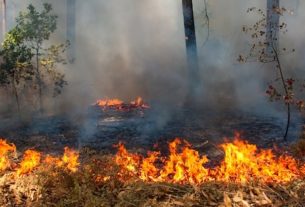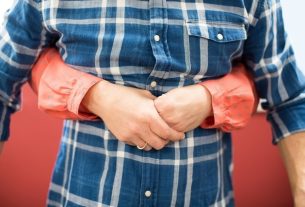A 3rd degree burn is the most serious type of burn, as it destroys the deepest layers of the skin and the layer of fat beneath the skin, and can also affect sweat glands, nerve endings, hair follicles, blood vessels, tendons, muscle or even bones.
This type of burn can be identified through symptoms such as a white, brown or charred plaque, with a leather-like texture, presenting little or no pain, due to the destruction of the nerves.
A 3rd degree burn is a serious situation that can be life-threatening, and therefore, you must seek medical help immediately, calling SAMU on 192 or go to the emergency room as quickly as possible.
Sensitive content
This image may contain content that is uncomfortable for some people.
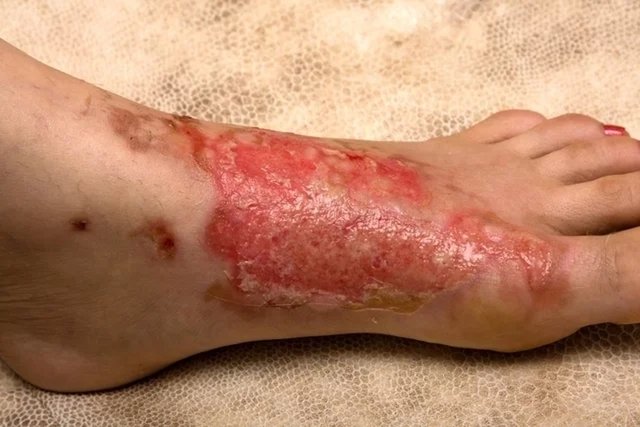
How to recognize 3rd degree burn
The main characteristics that help to recognize a 3rd degree burn are:
- White, brown, yellow or black plaque, with a charred appearance;
- Dry affected skin, with a leathery texture;
- Swelling in the affected region;
- Little or no pain.
Furthermore, this type of burn does not present blisters on the skin, like a 2nd degree burn. However, in some cases, the person may have 2nd degree burns, with blistering, close to a 3rd degree burn. Know how to identify a 2nd degree burn.
What can cause a 3rd degree burn?
3rd degree burns can be caused by thermal agents, such as fire, explosions, scalding liquids or very hot objects, or due to electricity, radiation or sun exposure.
Furthermore, this type of burn can also occur due to contact with chemical agents, such as acids, caustic soda, thinners or gasoline, for example, causing a chemical burn. See other causes of chemical burns and what to do.
First aid for 3rd degree burn
First aid for 3rd degree burns is:
- Call immediately to SAMU at number 192, or firefighters at number 193, or take the person to the emergency room as quickly as possible;
- Cool the affected area with 0.9% saline solutionor cold tap water, for about 10 minutes;
- Carefully place a moistened sterile gauze in saline solution or a clean cloth on the affected area until medical help arrives. If the burned area is very large, you can wrap a clean sheet moistened with 0.9% saline solution;
- Do not place any type of product in the affected region.
In all cases of 3rd degree burn, the person must go to the hospital as, in some cases, it can cause failure in several organs.
In these cases, if the victim has stopped breathing, cardiac massage should be started until medical help arrives. Learn how to do cardiac massage correctly.
What not to do
In cases of 3rd degree burns, no product should be applied to the affected area, such as alcohol, sugar, coffee grounds, butter, cooking oil, oily ointments, olive oil or toothpaste. You should also not apply ice to the burn.
Furthermore, it is important not to touch the burn to avoid infections and not to remove layers of detached skin.
How the treatment is carried out
The treatment of 3rd degree burns must be carried out in the hospital, generally with hospitalization, especially when it affects large areas of the body, so that serum can be applied to the vein for hydration and antibiotics and analgesics, debridement of the wound and, in some cases, skin graft may be required. Find out how skin grafting is done.
Furthermore, in the hospital the nurse must apply dressings to the affected region, using antibiotic and healing ointments, to promote wound healing and prevent or treat infections.
Read too: 14 treatments for 3rd degree burn
We regularly update our content with the latest scientific information, so that it maintains an exceptional level of quality.
Bibliography
- STONE Li, R.; et al. Advancements in Regenerative Strategies Through the Continuum of Burn Care. Front Pharmacol. 9. 672, 2018
- RIBEIRO, LM; et al. Bilateral third-degree burn of the legs: lower limb salvage with dermal regenerative matrix. Ann Burns Fire Disasters. 31. 3; 228-232, 2018
- GAO, G.; et al. Comparing the Curative Efficacy of Different Skin Grafting Methods for Third-Degree Burn Wounds. Med Sci Monit. 23. 2668-2673, 2017
- VO, A.; BENGEZI, O. Third-degree burns caused by ignition of chlorhexidine: A case report and systematic review of the literature. Plast Surg (Oakv). 22. 4; 264-6, 2014
- MINISTRY OF HEALTH. Manual for emergency treatment of burns. 2012. Available at: <https://bvsms.saude.gov.br/bvs/publicacoes/cartilha_tratamento_emergencia_queimaduras.pdf>. Accessed on 01 Sep 2023

Sign up for our newsletter and stay up to date with exclusive news
that can transform your routine!
Warning: Undefined array key "title" in /home/storelat/public_html/wp-content/plugins/link-whisper-premium/templates/frontend/related-posts.php on line 12
Warning: Undefined array key "title_tag" in /home/storelat/public_html/wp-content/plugins/link-whisper-premium/templates/frontend/related-posts.php on line 13

